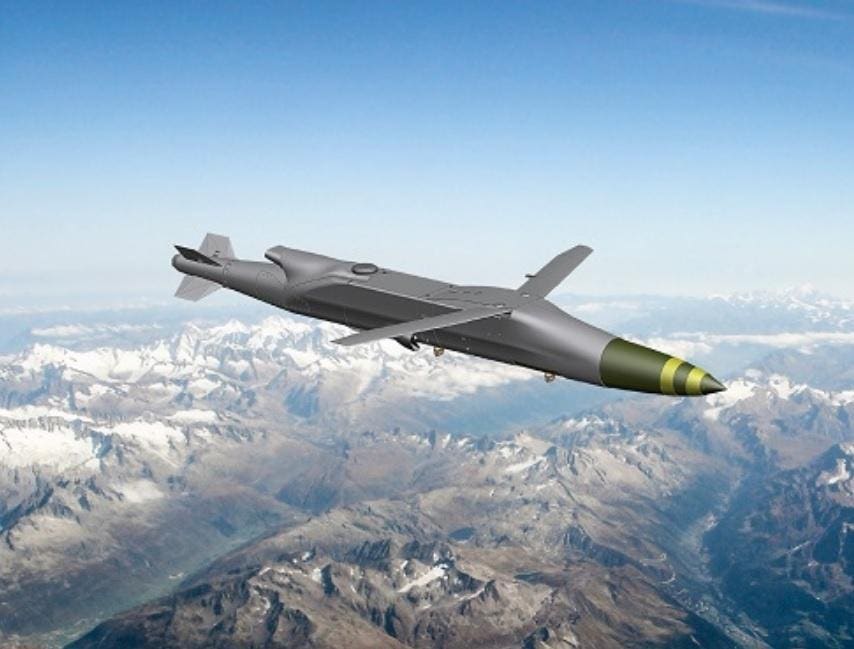An engine and wing kit for the widely used Joint Direct Attack Munition (JDAM) could turn it into a hyper-Kamikaze drone.
The Boeing-integrated kit transforms the JDAM into a “Powered JDAM” (PJDAM) consisting of a 500-pound gravity bomb, a conventional JDAM guidance system, a wing kit and a Kratos-TDI-J85 engine. The combination fits into the same form factor as a 2,000-pound bomb.
The preexisting JDAM kit, first developed in the 1990s, allowed for precision maneuvering/targeting of the munition but with a relatively short glide-range of approximately 13 miles. A later variant (JDAM-ER) included folding wings, allowing the bomb to glide in excess of 40 nautical miles and achieve practical utility as a precision standoff weapon.
By adding power via a small jet engine, the PJDAM gains impressive standoff range. A Boeing spokesman confirmed the munition can achieve a range “in excess” of 300 nautical miles with the kit in an email response to questions.
But the PJDAM could also function in other roles including deception. “If we swap in a fuel tank instead of a payload,” the spokesman said, “the range of a Powered JDAM decoy is in excess of 700 nautical miles.”
The ability to swap payload for fuel and/or the possibility of combining a smaller (sub-500 pound) munition with the kit suggests different PJDAM variants could have the ability to stay aloft for longer as a loitering munitions, potentially receiving updated targeting data as they fly.
On Monday, Boeing and Kratos Defense & Security Solutions (maker of the XQ-58 Valkyrie) announced a Memorandum of Understanding (MOU) between Technical Directions, Inc. (TDI), a business unit within Kratos Unmanned Systems Division, and Boeing for the TDI-J85 turbine engine to provide propulsion for the PJDAM.
Boeing has been at work on a long-range powered version of the JDAM for several years, seeking to give it cruise missile-like capability at a price well below cruise missiles. The effort assessed a number of powerplants and the deal with Kratos-TDI (initiated with an initial production order in late 2021) provides a relatively inexpensive engine that can be exported to JDAM partner nations (35 countries) as part of the kit without Foreign Military Sales complications.
Yesterday, Boeing announced an MOU with Brisbane, Australia-based Ferra Engineering which already makes JDAM-ER wing kits. The Boeing-Ferra MOU “includes the intent to continue production of JDAM ER wing kits, as well as the intent to explore applications for Powered JDAM,” according to Boeing.
Boeing’s spokesman did not make clear what is meant by exploring applications, whether that entails different Ferra-made wing kits for PJDAM variants (the PJDAM currently uses the same wing kit as the JDAM-ER) or a search for additional powerplant alternatives.
Bob Ciesla, Vice President of Boeing Precision Engagement Systems said in a joint release with Kratos-TDI that PJDAM’s “ability to complement exquisite weapons systems with low-cost stand-off capability will add new weapons capacity to the U.S. defense industrial base to support the current fight and deter future fights.”
Just how low-cost the new standoff capability is Boeing would not specifically say, merely referring to it as “affordable” without attaching any price figures. In 2020, the War Zone broke out costs for a number of missiles, rockets and bombs, putting the figure for JDAM kits for the U. S Air Force and Navy at $21,000 and $22,208 per unit respectively.
Obviously JDAM kit prices have risen since then and in a 2020 piece for Air & Space Forces magazine Boeing acknowledged that the PJDAM will cost more than a standard JDAM. In an emailed response to a question regarding the TDI-J85’s price, a Kratos spokesperson would only say that it is, “Low enough to make programs like P-JDAM a feasible, attractive, option.”
However, Boeing does claim “additional value” for the system based on its “ready adaptability to support different mission sets (e.g., land strike, maritime strike and maritime aerial mining).”
The kit nature of the PJDAM design means it could work with a variety of 500-pound munitions including specially designed penetrating, air blast or blast minimizing bombs but it also suggests the possibility of scaling up to larger weapons, perhaps up to 2,000 pounds.
While Boeing has not weighed in on the possibility of adding radar or other seeker systems, they could bolster the PJDAM’s role as an effective substitute for land or sea-attack cruise missiles. Its efficacy would be measured by its comparative affordability but with the unit cost of similarly capable missiles like the AGM-158A Joint Air-to-Surface Standoff Missile (JASSM) well above $1 million, there is some headroom.
The TDI-J85 is largest of a family of small turbojets developed by Michigan-based Technical Directions, Inc. which uses the tagline, “Small But Mighty”. Smaller though the company might be, it has channeled investment from both Northrop-Grumman and the Air Force Research Laboratory to develop the 200 lbf (88-890 N) thrust engine.
The little jet underwent a successful high altitude flight test campaign called Gray Wolf under AFRL auspices which sought powerplant development for a cheap cruise missile. While the Gray Wolf cruise missile concept remains in under-funded limbo, the Boeing-Kratos announcement hints at the prospect of a program of record acquisition for the PJDAM.
If the Pentagon’s Replicator drone program concept for cheaper, mass munitions is any kind of demand indication, the kits could become standard kit.
Read the full article here





